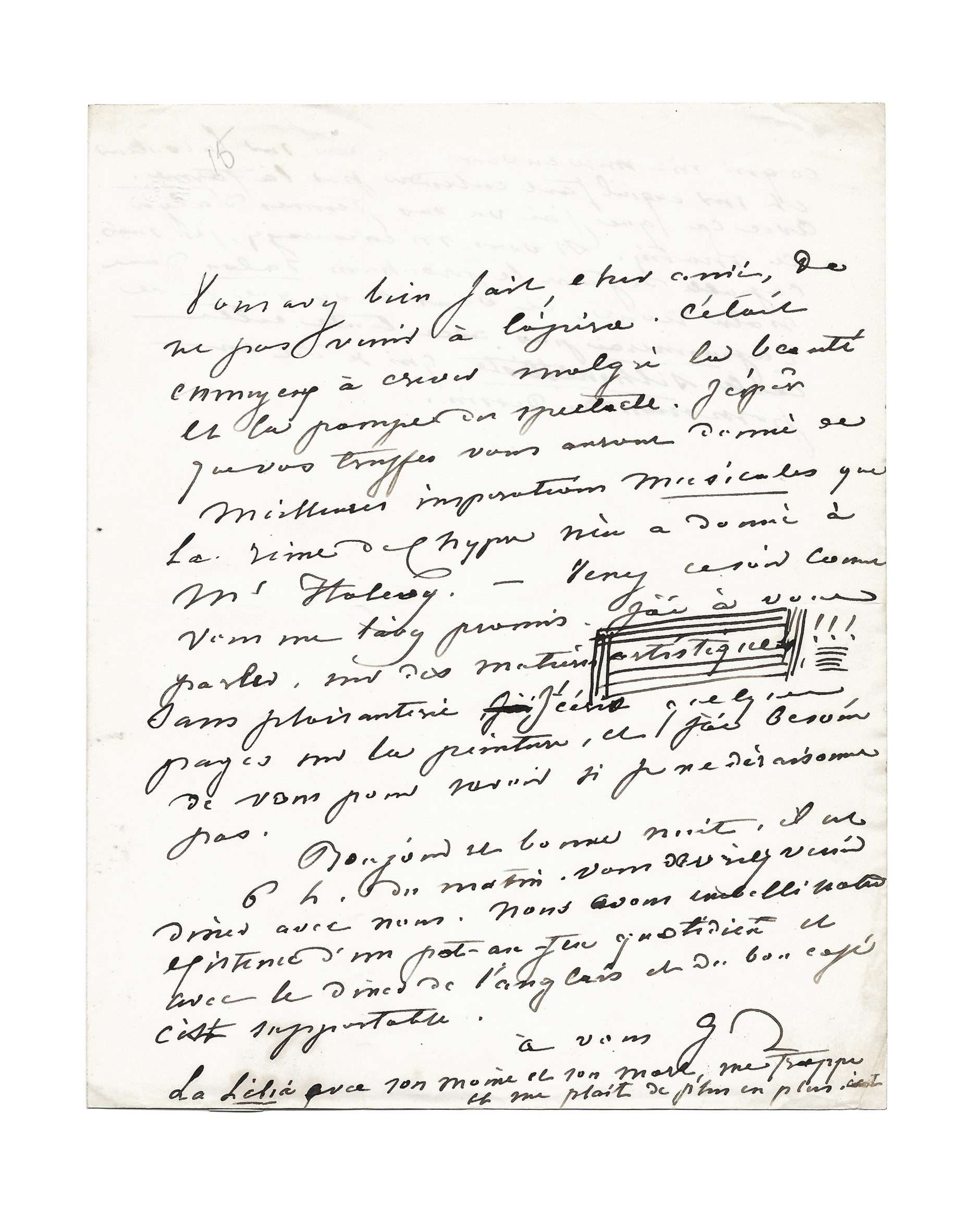[DELACROIX] SAND, George (1804-1876)
Autograph letter signed « G.S. » to Eugène Delacroix
[Paris] Postal mark [23rd December 1841], 1 p. 1/2 in-8°
« I saw your femmes d’Alger »
Fact sheet
[DELACROIX] SAND, George (1804-1876)
Autograph letter signed « G.S. » to Eugène Delacroix
[Paris] Postal mark [23rd December 1841], 1 p. 1/2 in-8°
Autograph address on fourth folio (wax seal) : « Monsieur Delacroix rue des Marais S[ain]t Germain, 17 »
Superb letter to her friend Delacroix about her desire to write “a few pages on painting”, the Femmes d’Alger, her contempt for the Ingresque school and other artistic news
« Vous avez bien fait, cher ami, de ne pas venir à l’Opéra. C’était ennuyeux à crever malgré la beauté et la pompe du spectacle. J’espère que vos truffes vous auront donné de meilleures inspirations musicales que la reine de Chypre n’en a donné à Mr Halevy.(1)
Venez ce soir comme vous me l’avez promis. J’ai à vous parler sur des matières artistiques !!! [le mot est entouré par Sand d’un triple trait de plume]. Sans plaisanterie, j’écris quelques pages sur la peinture, et j’ai besoin de vous pour savoir si je ne déraisonne pas. (2)
Bonjour et bonne nuit. Il est 6h du matin. Vous devriez venir dîner avec nous. Nous avons embelli notre existence d’un pot-au-feu quotidien et avec le dîner de l’anglais(3) et du bon café c’est supportable.
G.S.
La Lélia(4) avec son moine et son mort, me frappe et me plaît de plus en plus, c’est ce qui m’a mise en veine d’écrire sur la couleur et ce qu’il faut entendre par la forme. Avec ça j’ai vu vos femmes d’Alger(5) ce matin. Si vous m’encouragez, je suis capable de faire le prochain salon dans notre revue [La Revue indépendante], et vous savez que je ne caponnerai pas [ne se montrera pas lâche] avec tout cette école silhouettiste(6) qui se dit en possession du dessin ».
[1] La Reine de Chypre, an opera in five acts by Halévy to a libretto by St. George, took place the day before, December 22, 1841. Unlike George Sand, Richard Wagner, who was also present at the premiere, considered the music “noble, moved, and even new and exhilarating,” although he criticized Halévy’s failings in simple orchestration.
[2] In Horace, which George Sand was then writing, she staged a rapin, a pupil of Delacroix, but there were no “few pages on painting”. Is this an article intended for the Independent Review – which it has just created – but which it has renounced? The word written in postscript confirms that it is an aesthetic reflection that focuses on “color” and “form”.
[3] Possible reference to an English restaurateur or caterer frequented by George Sand.
[4] Lélia avec son moine et son mort is the third work offered by Delacroix to George Sand for the gifts of 1842. It is a pastel depicting Lélia kneeling near Stenio’s corpse, while the monk Magnus, “in the shadows, leaning stiffly against the wall of the cave, darted on her his sparkling eyes”. The subject was treated several times by Delacroix.
[5] This is the Femmes d’Alger dans leur appartement, a painting presented at the Salon of 1834, where it caused a sensation. A synthesis of orientalism and romanticism, this painting expresses a deep “melancholy” for the poet and art critic Baudelaire.
[6] George Sand refers to the school of Ingres as a “Silhouettist school”. We know the adversity between the two painters that animated the artistic scene of the nineteenth century. The writer had resolutely taken Delacroix’s side, that of “form” and “color”.
Bibliography:
George Sand – Correspondance, t. V, Lubin, Garnier, p. 529-531, lettre n°2369
Correspondance, éd. Françoise Alexandre, Les éditions de l’Amateur, p. 117-118, n°50
Provenance:
Achille Piron (Delacroix’s universal legatee)
Bibliothèque Marc Loliée



